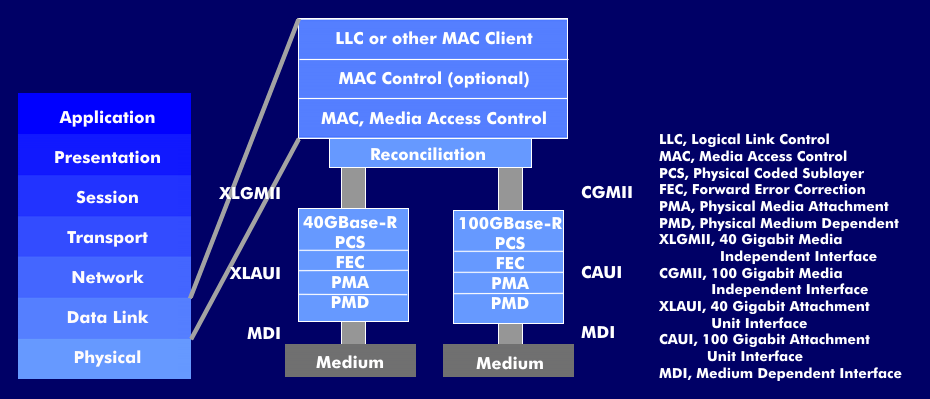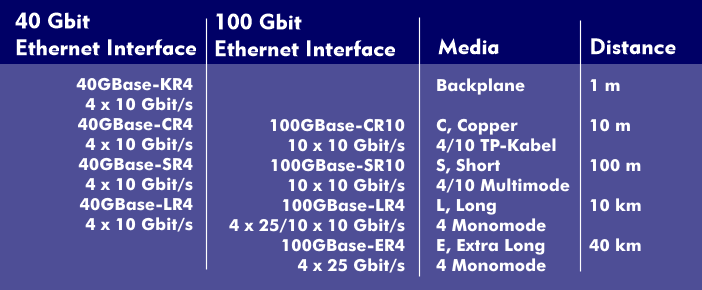100 Gigabit Ethernet (100GbE)
100 Gigabit Ethernet (100GbE) is a high-speed technology for network operators for aggregation in the Internet backbone, for server connections and for inter- switch connections in data centers.
The Higher Speed Study Group( HSSG) is driving this 100 Gigabit technology under the project name 802.3ba, and in addition to the 100 Gbps data rate, the 40 Gbps data rate used in optical transport networks( OTN), as 40 Gigabit Ethernet( 40GbE), is also included in the standard. In accordance with ITU-T recommendationG.709, the 100 Gbit/s signal can be integrated into an optical transport network (OTN) and transport Optical Transport Units (OTU4).
Various methods are available for achieving higher speeds and in particular 100 Gbit/s, such as parallel transmission of 10 Gbit/s each over ten copper lines or ten duplex multimode fibers, transmission of 25 Gbit/s over four multimode fibers or wavelength division multiplexing using short wave division multiplexing( SWDM) over four wavelengths, on each of which 25 Gbit/s are transmitted, or over two lanes with 50 Gbit/s each. Multimode fiber( MMF), wideband multimode fiber(WBMMF) and also copper cable, or twinaxial cable, are used as transmission media.
Classic Ethernet features for 100GbE
Certain Ethernet structures are retained for 100 Gigabit Ethernet. For example, the frame formats and the frame length with a minimum of 64 bits and a maximum of 1,518 bits. Unlike usual in Ethernet, the 64B66B coding is used as coding, in which fewer redundant bits are transmitted. Another aspect from Ethernet is the full duplex operation and the access method. Furthermore, it is about different algorithms like that of the Spanning Tree and about Virtual LAN( VLAN), as it is defined in 802.1Q. As a bit error rate, 100 Gigabit Ethernet provides for a value of better than '10^-12'. Such a value can only be achieved with Forward Error Correction( FEC).
For transmission over optical fiber, the errors caused by chromatic dispersion( CD) and polarization mode dispersion( PMD) must be handled. In addition, the efficiency for transmitting the 100 Gbps signals over the existing DWDM systems needs to be improved. The 100GbE interfaces specified by the 802.3ba working group take the aforementioned requirements into account, as well as the transmission media and bridgeable distances required in the various applications. In order to meet the increased requirements in the various fields of application, the 802.3ba working group regularly develops new interface specifications.
100GbE is designed to be sufficiently flexible. There are approaches in 25-, 50- and 100-Gbps technology, there is the 100-Gigabit backplane, as well as solutions coax technology and for single mode fibers. With the single-mode approach under 100GBase- DR, 100 Gigabit Ethernet can be transmitted over distances of up to 500 m via one lane.


